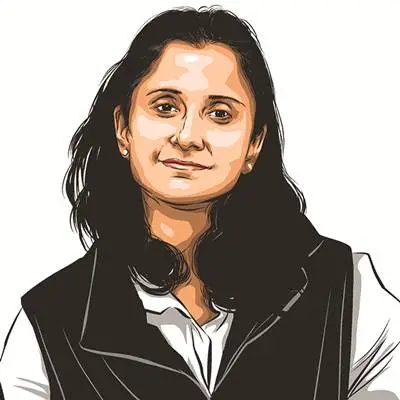Opinion If global art sales are plunging, how are Indian auctions hitting historic highs?
If the momentum continues, industry experts estimate the Indian art market to reach Rs 10,000 crore by 2030. Is this realistically achievable if the global collectors remain restrained?
 On the art front, meanwhile, inflated pricing and changes seen in collector preferences are also impacting the dynamics, with younger bidders gravitating more towards the relatively affordable contemporary segment. (File)
On the art front, meanwhile, inflated pricing and changes seen in collector preferences are also impacting the dynamics, with younger bidders gravitating more towards the relatively affordable contemporary segment. (File) Celebrated for creating value but criticised for propelling hype alongside, art auctions have always been subject to intense scrutiny. So, in May this year, when a 1955 bronze bust by Swiss artist Alberto Giacometti, with an estimate of $70 million, failed to find a buyer at a Sotheby’s auction in New York, it led to widespread shock and speculation about the future of premium art sales.
The result was unexpected, though perhaps not completely surprising, considering that days earlier, Andy Warhol’s 1967 Big Electric Chair, valued at $30 million, had been withdrawn from a Christie’s auction, presumably to avoid a similar fate.
The two events, however, did give the already struggling global art market a hint of the deeper challenges that likely await. Some of these concerns were affirmed when filings from Sotheby’s parent company, Bidfair Luxembourg, revealed that the auction house’s losses have increased to $248 million for 2024, from $106 million the previous year. Its rival auction house, Christie’s has also witnessed a decline in sales and is reportedly shutting its digital art department.
Christie’s and Sotheby’s are considered to be market makers with the power to influence pricing and perception. The grim revelations by both are therefore being viewed as indicative of future uncertainties in the art market, being shaped in no small measure by geopolitical shifts and political tensions in the Middle East and in Europe, including US President Donald Trump’s tariffs, the ongoing conflicts between Russia and Ukraine and in Gaza.
On the art front, meanwhile, inflated pricing and changes seen in collector preferences are also impacting the dynamics, with younger bidders gravitating more towards the relatively affordable contemporary segment. French database Artprice’s ‘Global Market Report for 2024’ revealed that compared to 2023, the global art auction turnover had dropped 33.5 per cent to $9.9 billion. While the number of lots sold was a record high at 804,000, nearly half of these were priced below $600.
In contradiction to the global sentiment, the Indian art market is exhibiting not just admirable resilience but also sustained growth. The ‘Indian Auction Market 2024’ report by Asign Data Sciences notes that the auction season saw “remarkable activity across 93 auctions conducted by nine auction houses”, generating a total turnover of Rs 1,558.97 crore. The highest demand was in the below Rs 5 lakh category, with 1,804 lots sold, followed by 1,287 lots in the Rs 5 lakh to 25 lakh range.
The recent months have also seen Indian art achieve significant milestones, including breaching the Rs 100-crore threshold with M F Husain’s Untitled (Gram Yatra, 1954) that fetched $13.75-13.8 million (Rs 118–119 crore) at a Christie’s auction in New York in March. The sale also marked a new record for the most expensive Indian artwork ever sold at an auction. Less than a month later, Tyeb Mehta’s 1956 canvas Trussed Bull garnered Rs 61.80 crore, making it the second-most expensive Indian artwork to come under the hammer.
Although analysts remain cautious, the broader consensus is that the growth momentum in India is driven by internal dynamics rather than external — led by the fast-growing economy, maturing seasoned collectors, rising disposable incomes and expanding base of young collectors. The Indian diaspora, meanwhile, views art both as an investment and means to connect with their cultural roots.
most read
Considered significantly undervalued compared to its global counterparts, Indian art also appeals to collectors seeking diversification. To put things in perspective, the highest price for an artwork sold at an auction is a staggering $450.3 million for Leonardo da Vinci’s Salvator Mundi at Christie’s in New York in 2017 — a figure that dwarfs MF Husain’s $13.75-13.8 million.
Though Indian art appears to be doing comparably better, scepticism remains. Inevitable comparisons are being drawn to the art surge of the ’90s, when prices in the contemporary segment suddenly soared and then drastically plummeted following the 2008 financial crisis.
Analysts argue that the upward trajectory, this time, has been more organic; accompanied by continued efforts by the rising number of private museums, galleries and artists to cultivate domestic interest, with increasing representation at prominent art forums, fairs and biennales. It is widely believed that it will take far more for the chips to fall, and the downturn, if any, will be measured. If the momentum continues, industry experts estimate the Indian art market to reach Rs 10,000 crore by 2030. Is this realistically achievable if the global collectors remain restrained? Can domestic demand remain insular from international volatility over a long period? While optimism is high, challenges are undeniable.
vandana.kalra@expressindia.com






